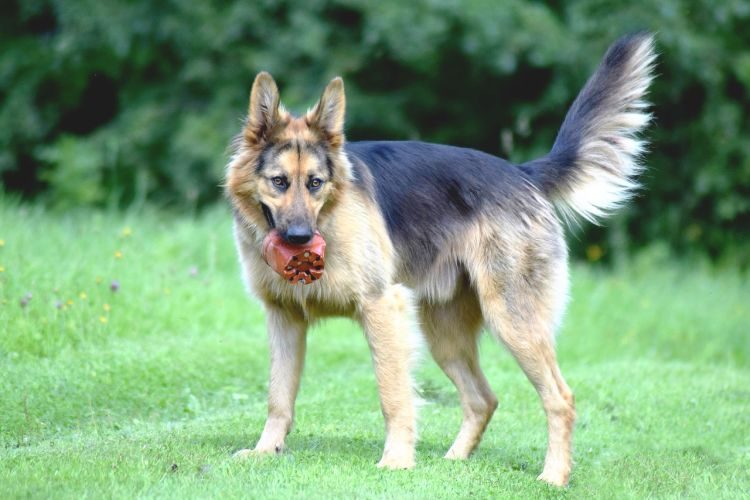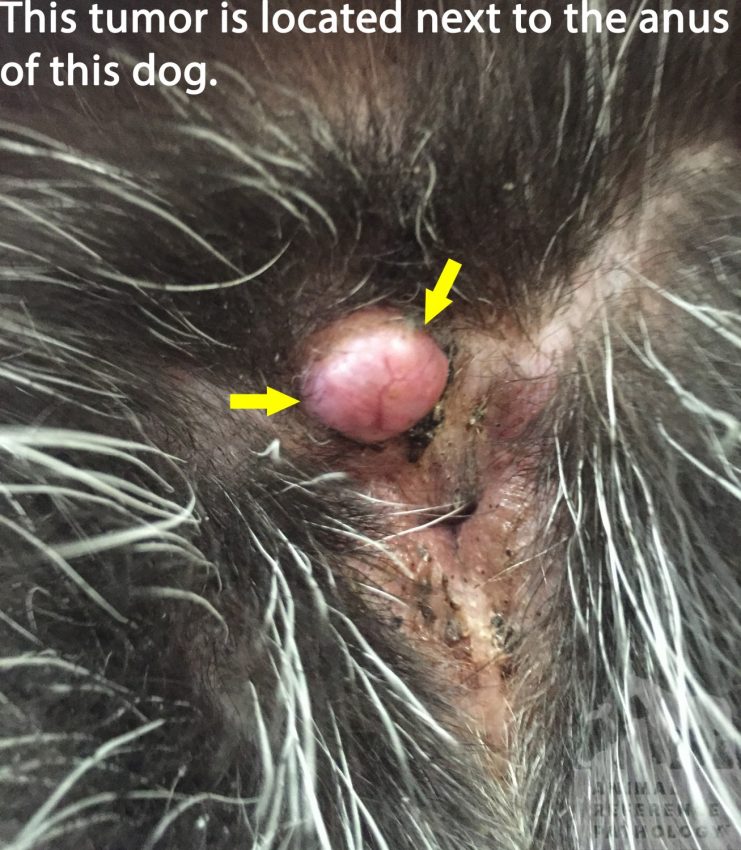
Ever noticed how things come in groups of 3?
Today I saw 3 dogs who were experiencing bleeding from the anal area. Two of them had anal tumors, while the other had an infected anal gland.
It occurred to me that anal tumors in dogs are a subject not much talked about but relatively common in male dogs.
Gus the GSD
Gus is a large, hairy German Shepherd Dog.
His appointment was to recheck a lump on his bottom. The week before, his human had noticed him bothering at his rear and leaving spots of blood on the floor where he sat.
The problem was a cherry-sized lump sitting at the “12 o’clock” position on the dog’s anal ring.
Somehow this lump had become ulcerated, and it was the raw surface that was bleeding.
Gus had been prescribed a course of antibiotics, and his human was bathing the lump in saltwater twice a day. As a result, at today’s follow-up, Gus was much more comfortable, and the lump had stopped bleeding.
I chatted with his human about the options for treatment going forward, and we decided to take a cautious approach and wait to see if the issue recurs, and if it does, then surgical removal is the next option. (More on surgery and its risks later.)
Problems Related to the Rear End
We’ll find out more about anal lumps in dogs in just a moment, but first, let’s take a look at what else might cause symptoms, such as a dog licking their rear end and bleeding from the bottom.
The main problems uppermost in this veterinarian’s mind are:
- Anal sac abscess: The anal sacs become infected and form an abscess that bursts. This is common.
- Anal furunculosis: This unpleasant condition occurs when the tissue around the anus simply melts away, leaving deep sores and tracts that are extremely painful for the dog.
- Anal adenoma in dogs: This is the most common type of cancer affecting the anus. Mainly found in male dogs, the male hormone testosterone stimulates their growth.
Here is a photo of an anal adenoma. Glance away if you don’t care to see a dog’s anus …

The most common tumor affecting the anal ring is the “anal adenoma.” This is a benign cancer, meaning it’s not aggressive and rarely spreads. However, anal adenomas in dogs can still cause problems if the tumors grow large.
While some anal adenomas are small, grow slowly and rarely cause a problem, this isn’t always the case.
Some grow quite large, break open and ulcerate, with the risk of infection because of where they are. Unfortunately, some of these ulcerated lumps can also bleed — sometimes quite a lot — which makes surgical removal necessary.
Why Male Dogs Get Anal Adenomas
Anal adenomas are a problem of elderly, unneutered male dogs.
This is because the adenomas are fed by the male hormone testosterone. Over a lifetime of being soaked in testosterone, sometimes the tissue of the anal ring forms tumors — it’s just the way it is.
This makes Gus’ case intriguing because he is neutered. However, he’s a rescue dog and as part of the terms of adoption, he’d been neutered (even though he was elderly) much later in life than is usual.
Was YOUR Pet Food Recalled?
Check Now: Blue Buffalo • Science Diet • Purina • Wellness • 4health • Canine Carry Outs • Friskies • Taste of the Wild • See 200+ more brands…

His age and history made Gus a candidate for anal adenoma formation.
But there’s also a chance that now that he’s neutered and his testosterone levels are lower, the lump may stop growing. Part of me wonders if he’d hidden the lump for a while — he’s extremely hairy around the rear.
Treatment for Anal Adenoma in Dogs
The main treatment for anal adenoma in dogs is surgical removal.
Once formed, these tumors are not likely to shrink down, and there’s always a risk of continued growth in intact male dogs. This means at the same surgery it’s wise to neuter the dog to prevent new adenomas from forming.
In elderly, frail patients for whom an anesthetic isn’t advisable, we can try to reduce future growth through medical treatment and the use of hormone implants to reduce testosterone levels. Sometimes this works; sometimes it doesn’t.
As well as the anesthetic risk, there’s also a chance of complications because of where the lumps grow:
- Obviously, the dog’s anus is not a sterile place, and there’s a risk of the operation site becoming contaminated with feces post-operatively. To reduce the risk of infection, the dedicated human syringes saltwater over their dog’s bottom after each bowel movement.
- In addition, there’s a theoretical risk of fecal incontinence following surgery. This is because the lumps grow on the anal ring, and during the operation there’s a small chance of nerve damage to the area.

Final Thoughts on Anal Adenoma in Dogs
In short, if you have a male dog, then desexing at a younger age can protect him from anal adenoma. If yours is an older, intact male dog, then be vigilant for lumps and bumps around the rear and get them checked by a vet.
Oh, and if your dog is super hairy, it’s a good idea to ask for a sanitary clip so you can keep an eye on what’s going on.
As for Gus, only time will tell if his lump continues to grow and be troublesome. But fortunately, his human is devoted and will act immediately should the need arise.
References
- “Perianal Gland Adenoma.” Animal Reference Pathology. https://www.animalreferencepathology.com/perianal-gland-adenoma.pml.
- Burgess, Kristine E., DVM, DACVIM, et al. “Identifying and Treating Anal Sac Adenocarcinoma in Dogs.” dvm360. Feb. 1, 2009. http://veterinarymedicine.dvm360.com/identifying-and-treating-anal-sac-adenocarcinoma-dogs.
- “Anal Sac Tumors in Dogs.” American College of Veterinary Surgeons. https://www.acvs.org/small-animal/anal-sac-tumors.
 This pet health content was written by a veterinarian, Dr. Pippa Elliott, BVMS, MRCVS. It was last reviewed Feb. 9, 2018.
This pet health content was written by a veterinarian, Dr. Pippa Elliott, BVMS, MRCVS. It was last reviewed Feb. 9, 2018. 

